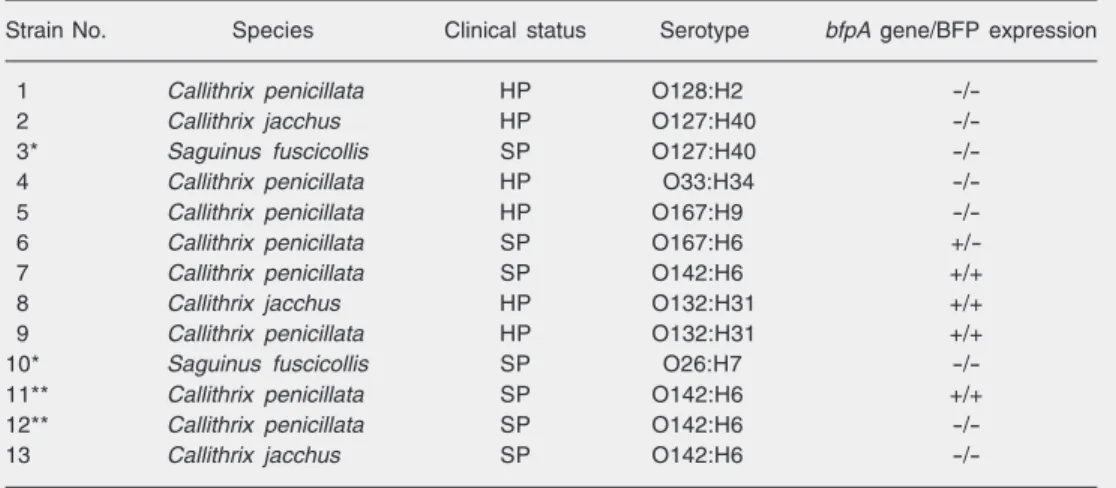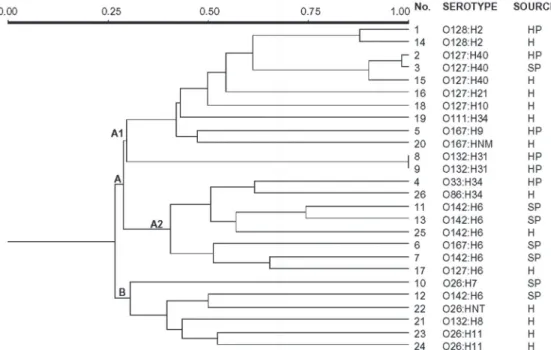Random amplification of polymorphic
DNA reveals clonal relationships
among enteropathogenic
Escherichia
coli
isolated from non-human primates
and humans
1Faculdade de Medicina Veterinária, Instituto de Ciências da Saúde,
Universidade Paulista, São Paulo, SP, Brasil 2Instituto Adolfo Lutz, São Paulo, SP, Brasil
3Departamento de Microbiologia, Instituto de Ciências Biomédicas, Universidade de São Paulo, São Paulo, SP, Brasil
V.M. Carvalho1, K. Irino2, D. Onuma3 and A.F. Pestana de Castro3
Abstract
Enteropathogenic Escherichia coli (EPEC) strains are important agents of infantile diarrhea all over the world, gaining even greater impor-tance in developing countries. EPEC have also been isolated from various animal species, but most isolates belong to serotypes that differ from those recovered from humans. However, it has been demonstrated that several isolates from non-human primates belong to the serogroups and/or serotypes related to those implicated in human disease. The objective of this study was to evaluate the genetic differences between thirteen strains isolated from non-human pri-mates and the same number of strains isolated from human infections. Human isolates belonged to the same serogroup/serotype as the monkey strains and the evaluation was done by analysis of random amplified polymorphic DNA. Dendrogram analysis showed that there was no clustering between human and monkey strains. Human and non-human isolates of the EPEC serotypes O127:H40 and O128:H2 shared 90 and 87% of their bands, respectively, indicating strong genomic similarity between the strains, leading to the speculation that they may have arisen from the same pathogenic clone. To our knowl-edge, this study is the first one comparing genomic similarity between human and non-human primate strains and the results provide further evidence that monkey EPEC strains correlate with human EPEC, as suggested in a previous investigation.
Correspondence
V.M. Carvalho Rua Dr. Bacelar, 1212 04026-002 São Paulo, SP Brasil
Fax: +55-11-6204-6471 E-mail: vaniamc@uol.com.br
Research supported by FAPESP, CNPq and CAPES.
Received May 23, 2006 Accepted September 25, 2006
Key words
•Escherichia coli •Enteropathogenic
Escherichia coli
•Attaching and effacing
Escherichia coli
•Attaching and effacing
•Monkey
•Random amplified polymorphic DNA
Enteropathogenic Escherichia coli (EPEC) strains are defined by the ability to induce the lesion called “attaching and effacing” com-bined with the inability to produce Shiga tox-ins, in such a way that diarrhea is the result of pathogen-host membrane interactions (1,2).
EPEC strains are agents of infantile diar-rhea all over the world, with even greater importance in developing countries, where the rate of infection and consequent infantile mortality reach higher levels (1,3).
have been isolated from healthy and diar-rheic animals of various species including pigs (4,5), cows (5,6), sheep and goats (5,7), dogs and cats (5,8), monkeys (9,10), and rabbits (11,12).
It has been recently demonstrated that several isolates from non-human primates belong to serogroups and/or serotypes re-lated to those implicated in human disease, including the traditional EPEC serogroups O26, O127, O128, and O142. Carvalho et al. (9) speculated that the isolates from non-human primates may have the same origin as the human strains. Thus, the objective of the present study was to obtain complementary genetic evidence testing this assumption by evaluating genomic differences between strains isolated from humans and from non-human primates using the analysis of poly-morphisms obtained by the random ampli-fied polymorphic DNA (RAPD) technique. Thirteen EPEC strains isolated from healthy and sick non-human primates, mostly marmosets, were compared with human strains belonging to the same serogroup/ serotype as the monkey isolates. Thrirteen human strains were obtained from children with diarrhea and selected from the culture collection of Instituto Adolfo Lutz, São Paulo,
SP, Brazil. The complete phenotypic and genotypic characterization of the monkey strains was described elsewhere (9,13) and is summarized here in Table 1.
E. coli strains were grown in 2 mL brain heart infusion broth and incubated aerobi-cally at 37ºC overnight with shaking. DNA extraction was performed according to the recommendations of the
Invitrogen-Easy-DNA™ kit, version E (Carlsbad,CA, USA).
DNA concentration and purity were evalu-ated by electrophoresis on a 0.8% submersed agarose gel stained with ethidium bromide. The high DNA mass ladder (Invitrogen) was used as a molecular size marker.
RAPD-PCR was performed according to a protocol described elsewhere (14) using the primers OPR-04 (5'-CCCGTAGCAC-3'), OPR-06 (5'-GTCTACGGCA-3') and OPR-08 (5'-CCCGTTGCCT3'). Each bacte-rial strain was analyzed in at least three independent reactions. PCR was carried out in an MJ Research model PTC-100™ ther-mal cycler (Watertown, MA, USA). The RAPD products were visualized by electro-phoresis on 1.4% agarose gels in 1X TBE (0.1 M Tris, 90 mM boric acid, and 1 mM EDTA, pH 8.3) stained with ethidium bro-mide. A 1-kb DNA ladder (Invitrogen) was
Table 1. Non-human primate EPEC strains isolated in the present study in Brazil.
Strain No. Species Clinical status Serotype bfpA gene/BFP expression
1 Callithrix penicillata HP O128:H2
-/-2 Callithrix jacchus HP O127:H40
-/-used as a molecular size marker.
The RAPD-PCR profiles were recorded and analyzed with the NTSYS-pc program (NTSYS-ps, 1992-Numerical Taxonomical and Multivariate Analysis System, Exeter Software, Setauked, NY), version 1.7.
The RAPD technique has been used in
the studyof the clonal relationship between
bacterial populations and is considered to be a useful tool for epidemiological studies (15,16). The aim of the present study was to compare human and non-human primate strains isolated in São Paulo State. The use of the three primers generated 111 polymor-phisms which were used in the construction of a binary matrix based on the presence or absence of shared bands. The dendrogram generated from the use of Dice coefficients is shown in Figure 1.
The results obtained showed that the dis-tribution of human and monkey EPEC oc-curred uniformly among the two main clus-ters, A and B, in contrast to the data reported by Venieri et al. (16), who demonstrated a differencebetween E. coli saprophyte strains isolated from animal and human sources.
Cluster B comprises all strains of
sero-type O26 studied, independent of their ori-gin, as well as serotypes O142:H6 and O132:H8 isolated from monkeys and hu-mans, respectively. This group included strainsrecovered from sick individuals only. Cluster A consisted of two other
sub-groups, A1 and A2. Subgroup A1 mainly
consisted of isolates originating from healthy monkeys and subgroup A2 consisted
pre-dominantly of isolatesoriginating from sick
primates.
The monkey serotypes O128:H2, O127: H40, O167:H9, and O132:H31 were detected
in cluster A1. The first two serogroupsare
widely referred to in the literature as the cause of diarrhea in children and the sero-types are prevalent in Brazil (3,17). Due to their characterization regarding the presence
and expression of bfpA/BFP and the intimin
subtype, in a previous study by Blanco et al. (13) the monkey isolates of the present study were considered to be human serotypes.
The genomic profile determined by the RAPD technique in strains of serotypes O128:H2 and O127:H40 demonstrated a close correlation between the isolates from monkeys and humans, corroborating
ous results (9). Strains belonging to serotype O128:H2 shared 87% of the band profiles while strains belonging to serotype O127: H40 shared 90% of the bands, a fact leading to the speculation that these strains could have a common ancestor pathogen strain. On the other hand, strains of serotype O167:H9 presented approximately 50% simi-larity to the human strain of the same sero-group. Although not included among the AEEC serotypes, O167:H9 was character-ized as such in an outbreak involving a large number of children in Japan (18).
The two isolates of serotype O132:H31 were shown to be identical even though they were recovered from different individuals belonging to the same institution (data not shown), supporting the idea that potentially pathogenic clones may disseminate among
individuals sharing the same environment.
These O132:H31 strains had approximately 30% band identity with the remaining clus-ter strains. Both presented and expressed the
bfpA gene, showing a subtype of intimin ß,
LEE, inserted in phe U and an FAS-positive
reaction (9,13). Despite showing human EPEC characteristics, the serotype is not included among human EPEC; however, serogroup O132 is related to infections in rabbits by REPEC (rabbit EPEC) in Brazil (12).
All isolates with the flagellar antigens
H6 and H34 were included in cluster A2,
with the majority of strainsbeing recovered
from sick monkeys. These results are similar
to those obtained by other investigators who studied the genetic relationship between hu-man EPEC serotypes (17,19). The pheno-typic and genopheno-typic characteristics of the strainswith these flagellar antigens allowed the authors to classify them as typical EPEC. In the present study, however, some of the
isolates did not present the bfpA gene
(O33:H34 and O142:H6) nor did they ex-press it in in vitro studies (O167:H6), despite their clonal relationship.
This is the first study comparing genom-ic similarity between human and non-human
primate strains.The genomic similarity
be-tween serotypes O128:H2 and O127:H40, isolated from humans and monkeys, which are prevalent in Brazil in children with diar-rhea (3,17), supports the previously raised hypothesis that monkeys carry human EPEC strains (9,13).These serotypes are classified as atypical EPEC and have been considered to be emergent human pathogens in devel-oping countries (3).
Non-human primates are important mod-els for the study of human disease, due to their phylogenetic proximity and similar sus-ceptibility to human pathogens (20). The verification that these animals carry human EPEC strains opens the possibility of using
these primates as models to studythese
in-fections, since Vallance and Finlay (2) em-phasized the need to study the pathogenesis
of EPEC in modelsgenetically and
attaching and effacing Escherichia coli strains isolated from diar-rhoeic lambs and goat kids. Microbiology 2001; 147: 2341-2353. 8. Nakazato G, Gyles C, Ziebell K, Keller R, Trabulsi LR, Gomes TA, et
al. Attaching and effacing Escherichia coli isolated from dogs in Brazil: characteristics and serotypic relationship to human entero-pathogenic E. coli (EPEC). Vet Microbiol 2004; 101: 269-277. 9. Carvalho VM, Gyles CL, Ziebell K, Ribeiro MA, Catao-Dias JL,
Sinhorini IL, et al. Characterization of monkey enteropathogenic Escherichia coli (EPEC) and human typical and atypical EPEC serotype isolates from Neotropical nonhuman primates. J Clin Mi-crobiol 2003; 41: 1225-1234.
10. Thomson JA, Scheffler JJ. Hemorrhagic typhlocolitis associated with attaching and effacing Escherichia coli in common marmosets. Lab Anim Sci 1996; 46: 275-279.
11. Milon A, Oswald E, De Rycke J. Rabbit EPEC: a model for the study of enteropathogenic Escherichia coli. Vet Res 1999; 30: 203-219. 12. Penteado AS, Ugrinovich LA, Blanco J, Blanco M, Blanco JE, Mora
A, et al. Serobiotypes and virulence genes of Escherichia coli strains isolated from diarrheic and healthy rabbits in Brazil. Vet Microbiol 2002; 89: 41-51.
13. Blanco M, Blanco JE, Blanco J, Carvalho VM, Onuma DL, Pestana de Castro AF. Typing of intimin (eae) genes in attaching and effac-ing Escherichiacoli strains from monkeys. J Clin Microbiol 2004; 42: 1382-1383.
14. Peixoto JC, Bando SY, Ordonez JA, Botelho BA, Trabulsi LR, Mo-reira-Filho CA. Genetic differences between Escherichia coli O26 strains isolated in Brazil and in other countries. FEMS Microbiol Lett 2001; 196: 239-244.
15. Girao DM, Bando SY, Girao VBC, Moreira-Filho CA, Fracalanzza SEL, Trabulsi LR, et al. Characterization of typical and atypical enteropathogenic Escherichia coli (EPEC) strains of the classical O55 serogroup by RAPD analysis. Rev Microbiol 1999; 30: 365-368.
16. Venieri D, Vantarakis A, Komninou G, Papapetropoulou M. Differen-tiation of faecal Escherichia coli from human and animal sources by random amplified polymorphic DNA-PCR (RAPD-PCR). Water Sci Technol 2004; 50: 193-198.
17. Campos LC, Franzolin MR, Trabulsi LR. Diarrheagenic Escherichia coli categories among the traditional enteropathogenic E. coli O serogroups - a review. Mem Inst Oswaldo Cruz 2004; 99: 545-552. 18. Ohtani Y, Kameda M, Tamura K. An outbreak of gastroenteritis possibly caused by Escherichia coli O167:H9. Kansenshogaku Zasshi 1991; 65: 35-39.
19. Whittam TS, McGraw EA. Clonal analysis of EPEC serogroups. Rev Microbiol 1996; 27: 7-16.

